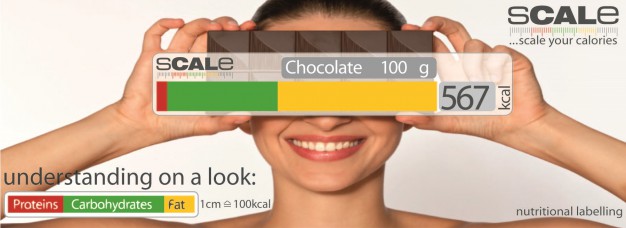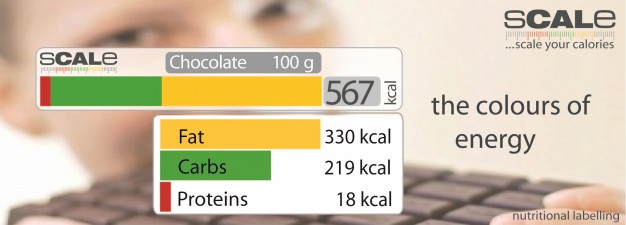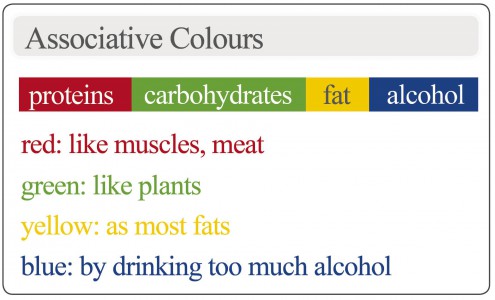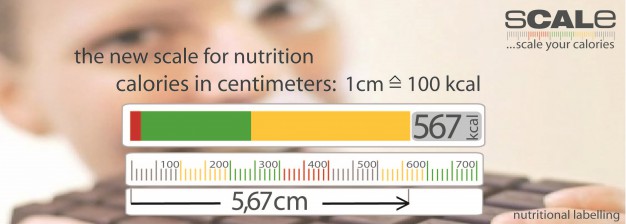sCALe – the alternative format of nutritional labelling
Here are our positions on „information to consumers about food“ and more information about nutritional labelling below.
The status quo
After years of work in nutritional theory and practice the sCALe model was developed. The word sCALe is chosen strategical, because sCALe consists two words:
- the familiar unit of energy, calories (cal)
- the parameter of a benchmarking base, a scale (scale)
As benchmarking base sCALe is a neutral parameter, which is easy to understand worldwide. An example showing practical application of sCALe.
“Less is more” and gives easy orientation directly on the packaging:
sCALe design: An example with 3 coloured sCALe, showing the main energy sources: proteins, fat, carbohydrates proportional to the total energy in kcal (labelling dummy of the Ferrero chocolate: Yogurette),
Our recommendation
In addition to the obligatory basic information about energy and nutrients, the type of representation is essential. Our sCALe concept offers an alternative model on nutritional information and labelling, while avoiding the limitations of traffic light and GDA-models. First survey results from consumers and scientists confirm that our sCALe model is easy to handle and understand for consumers. To get more information about consumer habits we need your support:
The first results show that the sCALe label is easy to understand for consumers.
Who we are
For many years, EgoFit has worked as health consultants in the area of nutrition, body analysis and human motion. Amongst other things, the sCALe was developed in that context. Our list of customers and cooperation partners includes WHO, NASA, DLR, Robert Koch Institute, medical institutions as well as health insurance providers and several health service providers.
The main idea of sCALe
To offer consumers a consciously reduced framework of a elementary nutritional information and thereby motivate to gain more knowledge.
– Focus on the main energy sources: protein, fat and carbohydrates. The visualisation can easily be expanded with additional energy content elements like saturates and sugars. All other nutritional facts besides energy carriers like salt or fibres could be mentioned separately.
– Easy to understand representation with associative colours and a specific graphical format, which could also be scientifically tested for comprehensibility according to the „draft report“ recommendation (see below).
A short summary of sCALe
The EgoFit-sCALe-concept starts at the point where based on substantiated scientific nutritional insights consumers have the need for easy to understand reference parameters which represent individual nutritional requirements. Based on those parameters, consumers will be able to optimize their personal eating habits ensuring a healthy energy balance according to their individual daily nutritional requirements.
As energy of food is always made up of main energy sources (protein, carbohydrate, fat and optional alcohol), it is obvious that only those are shown. The sCALe is giving an easy overview through associative colours:
The sCALe label as a form of visual representation forms a basic component of nutritional knowledge. With this didactic-methodology, additional knowledge can be taught in a simple and consistent way. Even preschoolers already identify the main sources of energy through the dominant colour rapidly.
The sCALe is giving nutrition the specific format
1 cm length of the sCALe always corresponds to 100 kcal of energy content. The sCALe in its total length easily visualizes the overall energy level of food, made up of the four main energy sources. Thus, a longer sCALe means more energy.
With sCALe it is easy to label packaging as well as loose items, for example on price tags. In addition, even „hidden“ sources in alcohol of energy such as in some kinds of liqueur will become obvious at a glance – the fat content comes into the foreground as the main energy source.





